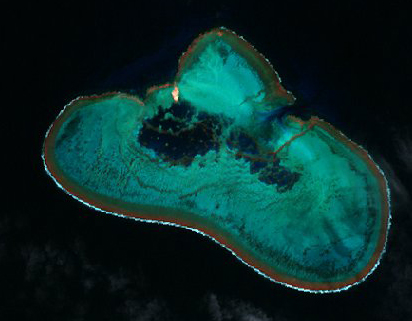Elizabeth Reef
This article needs additional citations for verification. (December 2007) |

Elizabeth Reef 29°57′25″S 159°4′32″E / 29.95694°S 159.07556°E is a coral reef in the Coral Sea. The reef is separated by a deep oceanic pass, some 45 km wide, from nearby Middleton Reef, both of which are part of the underwater plateau known as the Lord Howe Rise. It is around 160 km from Lord Howe Island and 555 km from the New South Wales coast of Australia. The Environment, Sport and Territories Legislation Amendment Act 1997 included Elizabeth Reef in Australia's Coral Sea Islands Territory.[1]
It is the southernmost coral atoll in the world and one of the southernmost platform reefs in the world. It measures 8.2 km by 5.5 km. Despite the relatively high latitude, a wide variety of flora and fauna exists on the reef and in the surrounding waters due to their location where tropical and temperate ocean currents converge.
At low tide most of the reef flat is exposed; at high tide, both a cay and a sand spit are visible. Elizabeth Island, with a diameter of about 400 m, is one metre above sea level. Elizabeth and Middleton Reefs form the Elizabeth and Middleton Reefs Marine National Park Reserve managed by the Government of Australia under the Natural Heritage Trust.[2]

Flora and fauna
Surveys by the Australian Institute of Marine Science have highlighted a healthy number of black cod Epinephelus daemelii, a threatened species[3] in New South Welsh waters.[4] The survey in 2003 highlighted 111 species of coral and identified 181 species of fish. The total number of recorded fish species is 311 across several surveys. High numbers of Galapagos sharks Carcharhinus galapagensis were observed at the reef, which may indicate that the reef is a nursery. Sea cucumber (black teatfish), Holothuria whitmaei,[5] were found in high numbers. While the 2003 survey found only small numbers of crown-of-thorns starfish, a survey in 2005 indicated that it was active.[6]
Shipwrecks
Both Elizabeth Reef and Middleton Reef have been the site of numerous shipwrecks. According to the National Shipwrecks Database, the ships stranded at Elizabeth Reef include: Britannia, Colonist, Douglas, Elizabeth, Naiad, Packet, Ramsay, Rosetta Joseph, and Tyrian.
Britannia is listed for both Elizabeth and Middleton Reefs.
British sailor Steve Landles was winched to a Royal Australian Navy Sea Hawk helicopter from the stranded yacht Lamachan on 2 August 2007; the yacht could not be recovered.[7]
See also
References
- ^ Prescott, Victor (1998). "The Uncertainties of Middleton and Elizabeth Reefs" (PDF). Maritime Studies. 1998 (100): 8–14. doi:10.1080/07266472.1998.10878528.
- ^ Elizabeth and Middleton Reefs Marine National Park Reserve Archived 2010-06-03 at the Wayback Machine
- ^ Black Cod net
- ^ Marine Surveys undertaken in the Elizabeth and Middleton Reefs Marine National Nature Reserve, December 2003 Archived 2008-08-02 at the Wayback Machine
- ^ Reefbase Online Library
- ^ "AIMS Reef Monitoring Elizabeth Reef". Archived from the original on 11 September 2007. Retrieved 16 August 2008.
- ^ Lamachan Rescue 1 August 2007

